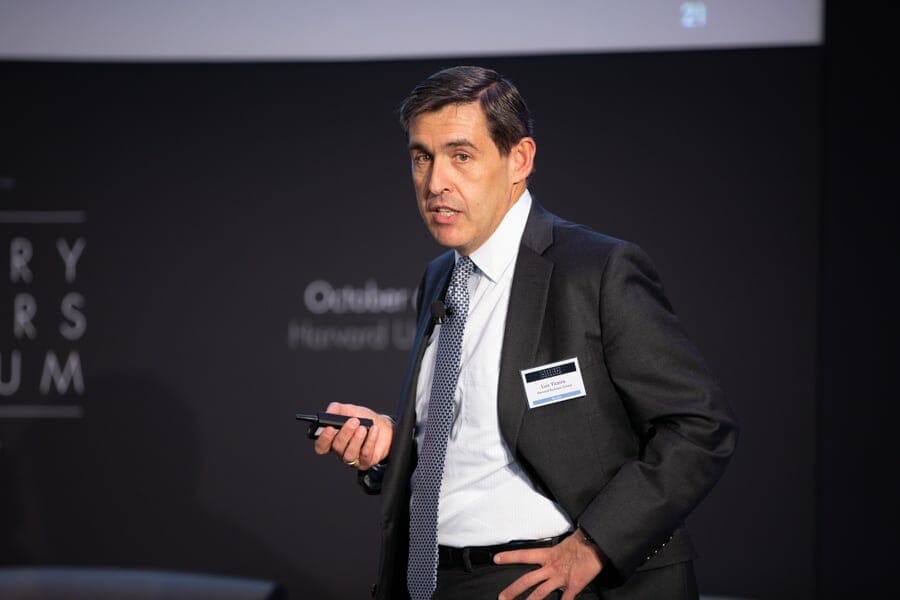A full-blown trade war, and changes in monetary policy triggered by a loss of credibility in the Federal Reserve and other global policy institutions, could result in a return of the positive correlation between bonds and stocks. Investors need to be aware of the risk, warned Luis Viceira, George E. Bates Professor in the Finance Unit and Senior Associate Dean for Executive Education at Harvard Business School, speaking at the Fiduciary Investors’ Symposium at Harvard University.
Viceira told delegates that funding liabilities and finding returns looked “as tough as ever” as all asset classes (including alternatives) remained expensive. Today’s environment is in stark contrast to 25 year ago, when buying government bonds netted 8 per cent returns. “This was an amazing world to be in. Today it is more like 2 per cent,” he said. This in turn has led to much flatter yield curves and more volatility in long term rates, he said.
Another change in today’s climate compared to previous decades is a new type of bond risk. In the 70s, 80s and 90s there was a high correlation between fixed income and equities. If the economy was “tanking,” investors would typically flee to liquidity and quality in commodities and cash, rather than government bonds. In contrast, in the last 20 years there has been a negative correlation between stocks and bonds that has seen investors flee from equities into bonds. We are now used to seeing government bonds as a type of hedge, he said.
This has important implications for how investors position their portfolio in the years ahead. Asset allocation is the first driver of performance, and the fundamental correlation between equities and bonds is front of mind for all investors. As bonds have become a hedge that allows pension funds to match their liabilities, so the negative stock/bond correlation has exacerbated risk in what Viceira described as a “perfect storm.”
In every past recession, inflation tended to rise and with it real interest rates as governments pulled monetary policy levers to try to cap rising prices. At this point, investors fled to cash and commodities rather than bonds in a strategy that drove bond prices down and yields up, and moved bonds positively with equities. In this scenario, bonds were not a good hedge, he said.
Since 2000, different trends have been at play. When the economy weakens with recession, inflation falls and interest rates tend to fall too. This has led to a flight to quality to fixed income, pushing prices up and yields down.
“You can see from this how the macro economy is connected to capital markets.”
The behaviour between the equity and bonds markets today amounts to a “huge change” in market dynamics, and something that investors positioning their portfolios for the next 10 years need to keep centre stage.
Viceira also noted the change in importance of supply and demand shocks, and the changing role of monetary policy. In earlier decades, supply shocks acted as a driving force to changes in growth and the business cycle. Monetary policy is also a key source of change. It used to be that monetary policy was primarily focused on curbing inflation with “aggressive counter inflation policies” hiking rates as soon as inflation reared its head. That has all changed. Now the focus is on fighting recession, and monetary policy has become more gradual and accommodating so that interest rates are not deployed at the first sign of inflation anymore.
In today’s market conditions, equities don’t do well, but because inflation also tends to fall, fixed income becomes sought after. In previous decades, supply shocks where the dominant force characterised by low output and higher inflation. In yesterday’s economic environment, fixed income was also a risky asset, he said. Yet today, fixed income does better in a recession, pushing bond prices higher. As interest rates are cut so it exacerbates the negative stock/bond correlation.
Change on the horizon
Viceira flagged that supply shocks, and growing criticism of the credibility of monetary policy, could impact today’s low inflation and flat yield curves in the years to come. The Federal Reserve is facing continued pressure on its credibility.
“There is a strong effort in the US to undermine the Fed,” he said. “We are also seeing this in other economies.”
For example, the ECB is under growing pressure regarding its rate cutting and monetary stimulus plans. This could result in changes of policy that result in bond markets moving in sync with equities once again, leaving equities and bonds down, and interest rates up. “This could happen,” he warns. Another factor that could change the current status quo is a supply shock.
It won’t be the energy shock of old. The world is less dependent on oil and many countries now produce their own.
“Energy is not the driving force of inflation any longer,” he says. Instead, this could come via a full blown trade war and, he warns, “prices are already changing.” The price of a basket of electric goods is rising because of tariffs. This could trigger inflation, rising interest rates and a return of the positive correlation between bonds and stocks.
“This is the worse way to bring interest rates to more normal levels,” he says “It would be a nightmare for everyone in the room. It would be much better to bring demand up in a world where demand is weak.”




